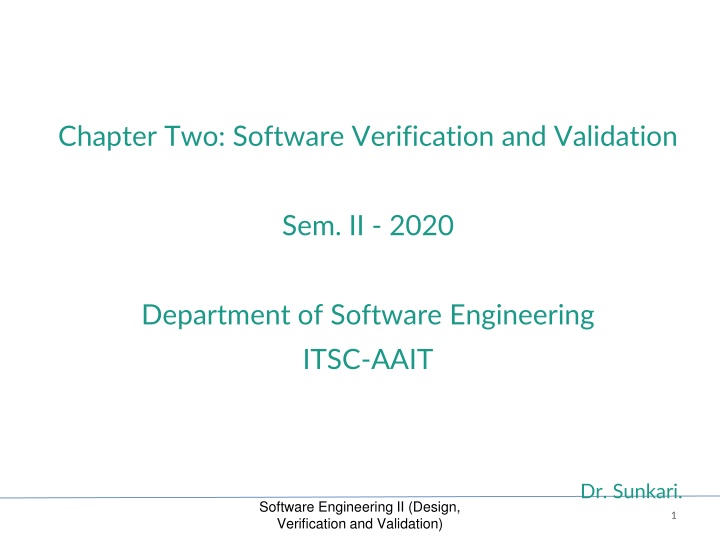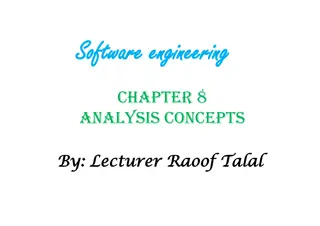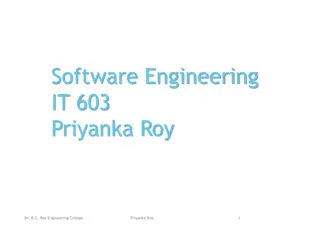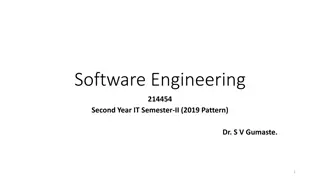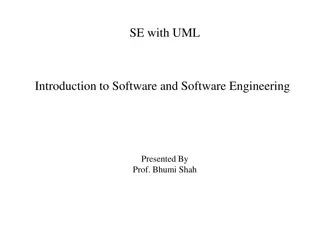Quality Revolution in Software Engineering
The concept of quality in software systems has evolved due to global competition and increased customer expectations. This revolution emphasizes integrating quality processes throughout product development, pushing quality down the organizational hierarchy, and continuous improvement efforts.
Download Presentation

Please find below an Image/Link to download the presentation.
The content on the website is provided AS IS for your information and personal use only. It may not be sold, licensed, or shared on other websites without obtaining consent from the author.If you encounter any issues during the download, it is possible that the publisher has removed the file from their server.
You are allowed to download the files provided on this website for personal or commercial use, subject to the condition that they are used lawfully. All files are the property of their respective owners.
The content on the website is provided AS IS for your information and personal use only. It may not be sold, licensed, or shared on other websites without obtaining consent from the author.
E N D
Presentation Transcript
Chapter Two: Software Verification and Validation Sem. II - 2020 Department of Software Engineering ITSC-AAIT Dr. Sunkari. Software Engineering II (Design, Verification and Validation) 1
Quality Revolution The concept of quality did not originate from software systems. Global competition, outsourcing, off-shoring, and increased customer expectations have brought the concept of quality to the forefront. Traditional Quality Assurance Improve quality around the end of the product development cycle The new quality assurance approach Quality assurance encompasses all phases of a product development process. Software Engineering II (Design, Verification and Validation) 2
Quality Revolution Effective Quality Process Paying much attention to customer s requirements Making efforts to continuously improve quality Integrating measurement processes with product design and development Pushing the quality concept down to the lowest level of the organization Developing a system-level perspective with an emphasis on methodology and process Eliminating waste through continuous improvement Software Engineering II (Design, Verification and Validation) 3
Quality Revolution A quality movement started in Japan (Statistical Quality Control) during the 1940s and the 1950s by William Edwards Deming, Joseph M. Juran, and Kaoru Ishikawa. Statistical quality control is a discipline based on measurements and statistics. Decisions are made and plans are developed based on the collection and evaluation of actual data in the form of metrics, rather than intuition and experience. They also introduced plan do check act (PDCA) cycle in the seminar, which he called the Shewhart cycle. Software Engineering II (Design, Verification and Validation) 4
Quality Revolution In 1954, Joseph M. Juran proposed raising the level of quality management from the manufacturing units to the entire organization. He stressed the importance of system thinking that begins with product requirement, design, prototype testing, proper equipment operations, and accurate process feedback. Juran spurred the move from SQC to TQC (total quality control) in Japan. This included companywide activities and education in quality control (QC), audits, quality circle, and promotion of quality management principles. Software Engineering II (Design, Verification and Validation) 5
Quality Revolution The key elements of Total Quality Control Quality comes first, not short-term profits. The customer comes first, not the producer. Decisions are based on facts and data. Management is participatory and respectful of all employees. Management is driven by cross-functional committees covering product planning, product design, purchasing, manufacturing, sales, marketing, and distribution. Software Engineering II (Design, Verification and Validation) 6
Quality Revolution Ishikawa or cause-and-effect diagram Found the four major causes of dispersion in product quality namely materials, machines, methods, and measurements, known as the 4 Ms. Software Engineering II (Design, Verification and Validation) 7
Software Quality Quality is context dependent. The five views of Quality ( Kitchenham and Pfleeger s) Transcendental View - something that can be recognized but is difficult to define. User View: fitness for purpose - Does the product satisfy user needs and expectations? Manufacturing View Quality as conformance to the specification. Product View: the inherent characteristics of the product. A product s inherent characteristics, that is, internal qualities, determine its external qualities. Value-Based View: depends on the amount of customer willing to pay for it. Software Engineering II (Design, Verification and Validation) 8
Software Quality McCall, Richards, and Walters were the first to study the concept of software quality in terms of quality factors and quality criteria. A quality factor represents a behavioral characteristic of a system. E.g- correctness, reliability , efficiency, testability , maintainability, and reusability. A quality criterion is an attribute of a quality factor that is related to software development. E.g Modularity is an attribute of architecture. Software Engineering II (Design, Verification and Validation) 9
Software Verification and Validation Both concepts are abstract in nature, and each can be realized by a set of concrete, executable activities. Verification Verification addresses the question, are we building the system right? Verification is concerned with whether the system is well-engineered, error-free, and so on. Verification will help to determine whether the software is of high quality, but it will not ensure that the system is useful. In traditional software development life cycle verification is stated as a technique to determine whether the product of a given development phase satisfies the requirements established before the start of that phase. A Product can be an intermediate product. Software Engineering II (Design, Verification and Validation) 10
Software Verification and Validation Verification activities confirming that one is building the product correctly review interim work products, such as requirements specification, design, code, and user manual, during a project life cycle to ensure their quality. Software Engineering II (Design, Verification and Validation) 11
Software Verification and Validation Validation Validation activities aim at confirming that a product meets its customer s expectations. Validation activities aim at confirming that one is building the correct product Performed toward the end of system development phase Software Engineering II (Design, Verification and Validation) 12
Software Verification and Validation Verification includes all the activities associated with the producing high quality software: testing, inspection, design analysis, specification analysis, and so on. It is a relatively objective process, in that if the various products and documents are expressed precisely enough, no subjective judgements should be needed in order to verify software. In contrast, validation is an extremely subjective process. It involves making subjective assessments of how well the (proposed) system addresses a real-world need. Validation includes activities such as requirements modelling, prototyping and user evaluation. Software Engineering II (Design, Verification and Validation) 13
Testing Concepts, Issues, and Techniques Software Engineering II (Design, Verification and Validation) 14
The Purpose of Testing Testing is the process of executing a program with the intent of finding errors. So, it is the execution of software and the observation of its behavior or outcome. If a failure is observed, the execution record is analyzed to locate and fix the fault(s) that caused the failure. The purpose of testing is To ensure that the software systems would work as expected when they are used by their target customers and users. Specifically, providing evidence of quality in the context of software quality assurance is the major purpose of software testing. Use Dry-Runs and Controlled Experimentation Therefore, the primary purposes of testing are To demonstrate quality or proper behavior; To detect and fix problems. Software Engineering II (Design, Verification and Validation) 15
Failure, Error, Fault, And Defect Failure A failure is said to occur whenever the external behavior of a system does not conform to that prescribed in the system specification. Error a state of the system that could lead to failure. In the absence of any corrective action by the system, an error state could lead to a failure which would not be attributed to any event subsequent to the error. Fault A fault is the announced cause of an error. Failure Manifestation: fault error failure. Defects ? Faults Cause ? effect Software Engineering II (Design, Verification and Validation) 16
Generic Testing Process Test planning and preparation, which set the goals for testing, select an overall testing strategy, and prepare specific test cases and the general test procedure. Test execution and related activities, which also include related observation and measurement of product behavior. Analysis and Follow-up, which include result checking and analysis to determine if a failure has been observed, and if so, follow-up activities are initiated and monitored to ensure removal of the underlying causes, or faults, that led to the observed failures in the first place. Software Engineering II (Design, Verification and Validation) 17
Test Planning and Preparation Test planning and preparation include the following sub-activities: Goal setting: Concerned with setting specific testing goals that complies with goal setting for the overall quality engineering process. Reliability or Coverage Goals Test case preparation: includes constructing new test cases or generating them automatically, selecting from existing ones for legacy products, and organizing them in some systematic ways for easy execution and management. More on this later, test case design Test procedure preparation: a formal procedure is more of a necessity than a luxury for complex software systems. To ensure effective test execution, problem handling and resolution, and the overall test process management. 3/22/2018 Software Engineering II (Design, Verification and Validation) 18
Functional Vs. Structural Testing Differ in perspective and the related focus. Functional Testing focus on the external behavior of a software system or its various components, while viewing the object to be tested as a black-box that prevents us from seeing the contents inside. Structural testing focus on the internal implementation, while viewing the object to be tested as a white-box that allows us to see the contents inside. Software Engineering II (Design, Verification and Validation) 19
Functional Testing (Black Box Testing) Verifies the correct handling of the external functions provided by the software, through the observation of the program external behavior during execution. Then, why is it entitled Black Box? Ad hoc Testing is the simplest form of BBT in which the difference between expected and actual behavior is observed by running the system with an arbitrary input. Specification Checklists are also commonly used. It contains list of the external functions that are supposed to be presented, as well as some information about the expected behavior or input-output pairing. The more formal way to undertake Black Box Testing bases on models which are derived from requirement/functional specification. Software Engineering II (Design, Verification and Validation) 20
Generic BBT Process Test Planning - the focus is on identifying the external functions to test, and deriving input conditions to test these functions. Identifying the external functions to test based on user expectations Deriving input conditions to test these functions Test execution - use to observe the external behavior, to ensure orderly execution of all the test cases, and to record execution information for analysis and follow-up activities. Testing Oracle Problem Comparison to determine if it is expected behavior or if a failure occurred. Follow-up activities - detects and removes corresponding faults succeeding failures in the test execution phase.. Software Engineering II (Design, Verification and Validation) 21
Structural Testing (White Box Testing) Structural testing verifies the correct implementation of internal units, such as program statements, data structures, blocks, etc., and relations among them. The software is treated as a white-box, or more appropriately a glass-box or a transparent box, where one can see through to view the internal units and their interconnections, it is also commonly referred to as white-box testing (WBT). The connection between execution behavior and internal units must be established. The simplest form of WBT is statement coverage testing through the use of various debugging tools, or debuggers, which help us in tracing through program executions. More formalized and systematic Testing models are derived from system implementation details. Software Engineering II (Design, Verification and Validation) 22
Structural Testing Due to the possibility of combinatorial explosions to cover these implementation details, WBT is typically limited to a small scale. Test planning plays a much less important role in WBT than in BBT. For small products, not much formal testing process is needed to plan and execute test cases, and to follow up on execution results. Software Engineering II (Design, Verification and Validation) 23
Comparing BBT with WBT Perspective - BBT views the objects of testing as a black-box while focusing on testing the input-output relations or external functional behavior; while WBT views the objects as a glass-box where internal implementation details are visible and tested. Objects - WBT is generally used to test small objects, such as small software products or small units of large software products; while BBT is generally more suitable for large software systems or substantial parts of them as a whole. Timeline: WBT is used more in early sub-phases of testing for large software systems, such as unit and component testing, while BBT is used more in late sub-phases, such as system and acceptance testing. Software Engineering II (Design, Verification and Validation) 24
Comparing BBT with WBT Defect focus: In BBT, failures related to specific external functions can be observed, leading to corresponding faults being detected and removed. In WBT, failures related to internal implementations can be observed, leading to corresponding faults being detected and removed directly. Defect detection and filing: Defects detected through WBT are easier to fix than those through BBT because of the direct connection between the observed failures and program units and implementation details in WBT. WBT does not uncover omission and design problems but BBT is efficient in detecting and fixing problems of interfaces and interactions. Software Engineering II (Design, Verification and Validation) 25
Comparing BBT with WBT Techniques: Various techniques can be used to build models and generate test cases to perform systematic BBT, and others can be used for WBT, with some of the same techniques being able to be used for both WBT and BBT. A specific technique is a BBT if external functions are modeled; while the same technique can be a WBT if internal implementations are modeled. Tester: BBT is typically performed by dedicated professional testers, and could also be performed by third-party personnel in a setting of IV&V (independent verification and validation); while WBT is often performed by developers themselves. Software Engineering II (Design, Verification and Validation) 26
Concept Of Complete Testing Complete testing is near impossible because of the following reasons Size of possible inputs The domain of possible inputs of a program is too large to be completely used in testing a system. Complexity of Design Issue The design may have included implicit design decisions and assumptions. Execution Environments It may not be possible to create all possible execution environments of the system. Software Engineering II (Design, Verification and Validation) 27
Test-Case Design The most important consideration in program testing is the design and creation of effective test cases. Test-case design is so important because complete testing is impossible; a test of any program must be necessarily incomplete. Given constraints on time and cost, the key issue of testing becomes What subset of all possible test cases has the highest probability of detecting the most errors? Reasonably rigorous test could be undertaken by using certain black-box-oriented test-case-design methodologies and then supplementing these test cases by examining the logic of the program, using white-box methods. Software Engineering II (Design, Verification and Validation) 28
Test-Case Design Black Box White Box Equivalence Class partitioning Statement coverage Boundary-value analysis Decision coverage Cause-effect graphing Condition coverage Error guessing Decision-condition coverage Multiple-condition coverage It is recommended that you use a combination of most, if not all, of the methods to design a rigorous test of a program, since each method has distinct strengths and weaknesses. The recommended procedure is to develop test cases using the black-box methods and then develop supplementary test cases as necessary with white-box methods. Software Engineering II (Design, Verification and Validation) 29
Notion Of Software Reliability Software reliability is defined as the probability of failure-free operation of a software system for a specified time in a specified environment. The level of reliability of a system depends on those inputs that cause failures to be observed by the end users. It is a quantitative measure that is useful in assessing the quality of a software One could use random testing to check the reliability of software. Moreover, test data must be drawn from the input distribution to closely resemble the future usage of the system. Capturing the future usage pattern of a system in a general sense is described in a form called the operational profile. Software Engineering II (Design, Verification and Validation) 30
Reading Glenford J. Myers, The Art of Software Testing , John Wiley & Sons, Inc., 2nd Ed., 2004 Page [64-112]. Kshirasagar Naik and Priyadarshi Tripathy, Software Testing and Quality Assurance - Theory and Practice , University of Waterloo, 2008 page [1-31]. Jeff Tian, Software Quality Engineering - Testing, Quality Assurance, and Quantifiable Improvement , Southern Methodist University - Department of Computer Science and Engineering, 2005 page [96 - 100] And read other online references Software Engineering II (Design, Verification and Validation) 31
